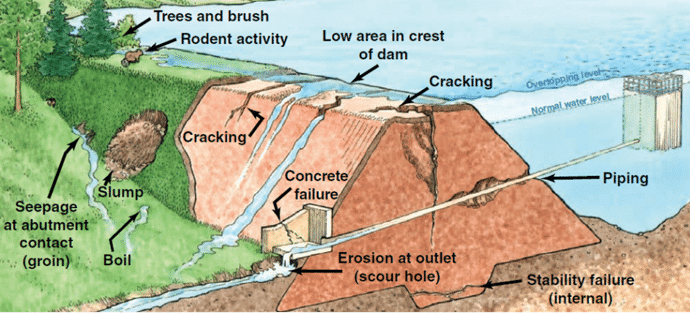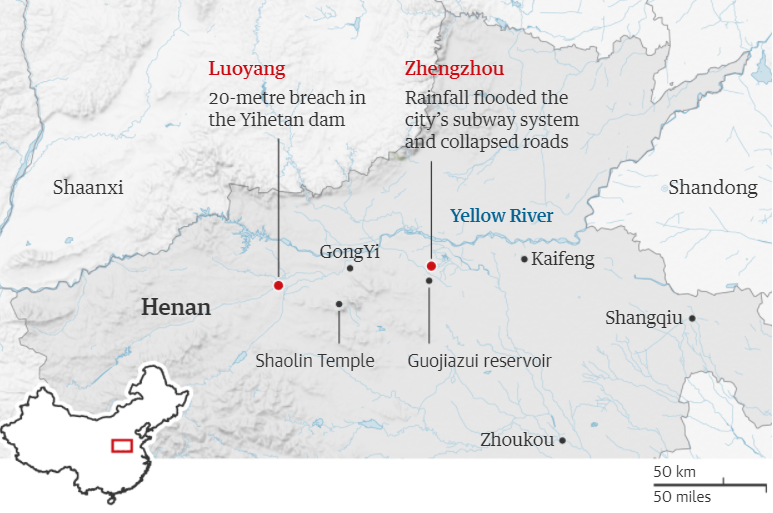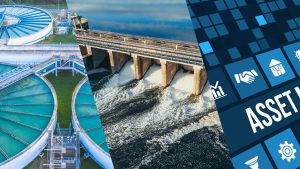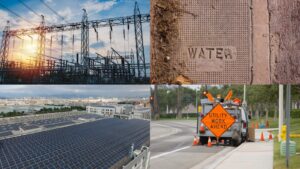Are dams controlling floods or accused of being triggers to catastrophic flood disasters worldwide? What are the best measures to be taken to mitigate the detrimental impacts exerted by floods on the health and security of water dams? Are new-age water dam manoeuvres competent in making dam infrastructures resilient to unpredictable flood strikes? Water dams are regarded as a universal symbol of human ingenuity. However, master-dam builders are frequently challenged by uncertain climatic and environmental changes that have led to destroying dam infrastructures and resulting in death and harmful consequences for the neighbouring biodiversity of dams. Thus, as much as diverting water for community usages, making water dams resilient to unprecedented disasters and maintaining them confidently requires great effort and precautions. Today we focus on educating the reader on how deluges -like floods- challenge water dam infrastructure managers and how to avoid unfortunate outcomes using technological solutions.
A Brief Understanding Of Dam Failures
Dam failures do not confine to insecurity and instability of a dam because a dam failure is more than that- it is also an array of consequences charged in property, life and environmental damages or fatalities. One of the most common failures in dams is caused by overtopping. Dam overtopping is a failure caused due to the held back water volumes surpassing the dam limit due to heavy floods or inadequate spillway capabilities. The picture shown below illustrates some of the leading causes of dam failures.

- Cracking of abutments, dam structures, spillages and other catchment infrastructural components
- Excessive exposure of materials drive to accelerated material degradation
- Frost damages
- Inaccurate parameters of silting conditions
- Inadequate engineering, movement and subsidences in spillways and dam foundations
- Invariant temperature changes throughout the dam infrastructure
- Inferior quality materials that can withstand dynamic environments
- Porous Concrete
- Seismic Load Action
- Soil erosion, floods and other natural disasters
- Swelling of clay blankets
- Undetected pipe erosion or failed structures of pipelines
- Unpredicted wave actions
- Other environmental impacts like animal issues, human activities like dynamiting and more.
Recorded flood impacts on Dam Infrastructures
- Dysfunctioning Urban Drainage Basins
- Global Warming leading to melting ice,
- Heavy rainfall,
- Lack of Trees,
- Overflowing rivers,
- Steep Slides,
- Tsunamis,
- Unprecedented Storms and more.
With a failed understanding of dam failures, the relevant flood-impacted risks cannot be reduced and managed. Unmanaged basins can lead to flooding events with dire consequences too. Here are some instances where flooding has led to the destruction of water dams and widespread, diverse ecosystems. To get a clear understanding of how flooding can be catastrophic to dam infrastructures and communities, let us look at two recent calamities rooted in recent flood disasters.
20 July 2021 - Chinese Army Warns About Dam Collapse Due To Being Battered By The Storm
The Chinese Army bewildered the centre of China by saying that the Xiaolangdi Reservoir Dam in Luoyang “could collapse at any time” after the torrential storm battered the dam to crumble. The Yihetan Dam suffered a breach that spread for 20 metres long, severely damaging the dam and is recognised as a worse threat than the past decades. The consequences of the dam rapture lead to the displacement of over 200,000 Chinese citizens; 3 million people were affected, 8 missing. It was also reported that two people died due to a wall collapsing, and an estimated 25 losing lives in Zhengzhou, according to state-run People’s Daily. This incident led to the damaging of reservoirs, dams, metro systems, hospitals, subways, roads and many more infrastructures. The image below gives a bird’s eye view of this unfortunate incident.

17 July 2021 - Severe Deluges Causes Devastation in Germany and Belgium
Dodging Flood Risks with The Power of Technology
Dodging Flood Risks with The Power of Technology
By initiating A Flood Alarm System
- Modelling the existing sewage system
With comprehensive factual and data collections about the potentials of sewage capabilities of a city like information about pipe diameters, inlets location, number of households, wastewater volumes, domain experts and IT specialists can engineer a sewage model. This model will support in triggering flood alarms during catastrophic events- giving enough time for the decision-makers to make decisions and the community to evacuate without harm. - Simulating realistic (but hypothetical) flood events
Due to the limitation of historical data, the sewage model can be used to create specific events to quantify relationships between flooding events and the reliability of the existing sewage system. These simulations can help in learning an algorithm that can be trained and tested using historical flooding events to predict flood impacts and volumes accurately. Harnessing a smart algorithm that can predict outcomes based on actual precipitation levels and sewage capacities, decision-makers can take resilient measures to minimise and prevent dam infrastructure damages. - Precipitation Forecasts
Systems can be built to forecast several possible weather forecasts based on historical data rather than locking into one ‘best guess’. It is fascinating that a combination of simple statistics can estimate the probability bandwidth of flood events when these weather forecasts are interrelated with a smart algorithm that predicts flood volumes. The trained algorithm built in the previous step can run these forecasts to compute accurate flood volumes based on each weather forecast in minutes. - Flood Alarm Trigger System
When the computations foreshadow possible flood events against pre-set trigger values, people in charge will be alerted with automatic flood warning alarms via the shared platform. If this system is empowered with prescriptive technology, it would even suggest the required actions such as the lever coordinates of spillways that the operators must follow to reduce the impact of the flood on the dam infrastructure.
Support Vector Machines
Digital Twin Technologies that Mockup Water Dam Infrastructure
A Concluding Thought
The pervasive effects of floods have caused detrimental overfills and catastrophic infrastructural failure to many water dams across the globe. With the world heating from global warming, the impacts of floods are likely to rise in the future. If critical infrastructure managers fail to predict impending deluges, they are being thrown to the edge of figuring out when and where climate change will occur and how to take the futureproof initiative to save dam infrastructures and the sustainability of biodiversity. To conclude, we would like to share a few innovative, practical initiatives taken by countries struck by floods every year.
- Movable Storm Surge Barriers
- Quick Flood Barrier Socks and Flood Blocks are faster solutions to control the impacts of floods
- Reusable barrier gate that seals entrances from being surged in from floodwater
- Using an easily deployable water gate system made of PVC to mitigate water pressure on dams (a better alternative to sandbags)
- Water Inflated Property Protectors that fights water with inflated water balloons along the perimeters of properties







